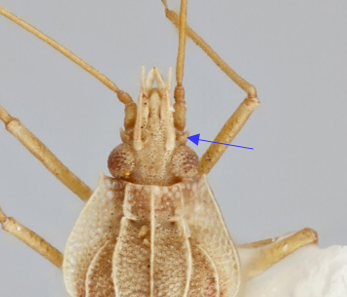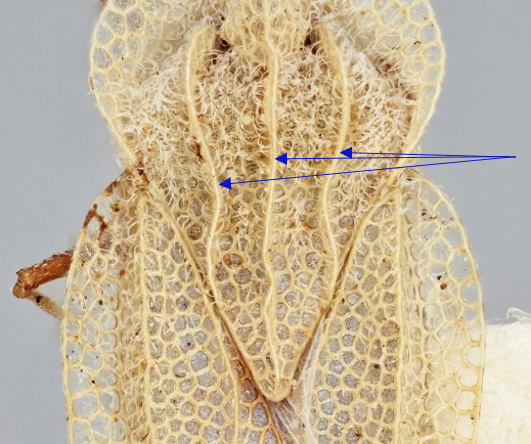Taxonomy
Acalypta Westwood, 1840
Type species: Tingis carinata Panzer
Diagnostic characters
Several morphological characters that usually remain constant within tingid genera vary considerably between polymorphic forms within this Holarctic genus. The polymorphic differences include size and convexity of the pronotumpronotum:
dorsal sclerite of the first thoracic segment
, spacing of the coxae, form and length of the hemelytrahemelytra:
one of the basally thickened forewings of Hemiptera
, presence or absence of the hindwings, and general habitus.
Characters diagnostic for the genus: head short, clypeus not surpassing apical half of first antennal segment; cephalic spinescephalic spines:
a spine on the head
 present, less than 5 spines; antenniferous processesantenniferous processes:
present, less than 5 spines; antenniferous processesantenniferous processes:
the socket in which antenna is inserted in the head; also known as antennophore, antennal tubercles, or antennal process
 prominent; pronotumpronotum:
prominent; pronotumpronotum:
dorsal sclerite of the first thoracic segment
uni- or tricarinatetricarinate:
bearing both median carina and lateral carinae on pronotum
 ; paranotumparanotum:
; paranotumparanotum:
lateral extension of pronotum; may be carinate, explanate, or reflexed
 widely expanded, not reflexedreflexed:
widely expanded, not reflexedreflexed:
bent or curved backwards, as in a reflexed paranotum
 ; pronotal hoodhood:
; pronotal hoodhood:
term used to describe the modified anterior area of the pronotum, which is sometimes tectiform and sometimes bulbous, with numerous intermediate conditions.
 tectiform, not bulbous; hemelytrahemelytra:
tectiform, not bulbous; hemelytrahemelytra:
one of the basally thickened forewings of Hemiptera
with claval areaclaval area:
parallel-sided and sharply pointed anal area of hemelytron
 weakly developed, almost entirely covered by posterior margin of pronotumpronotum:
weakly developed, almost entirely covered by posterior margin of pronotumpronotum:
dorsal sclerite of the first thoracic segment
; discoidal areadiscoidal area:
area of the forewing posterior to the subcostal area
 flat, extending beyond the middle of hemelytrahemelytra:
flat, extending beyond the middle of hemelytrahemelytra:
one of the basally thickened forewings of Hemiptera
(Drake and Lattin 1963Drake and Lattin 1963:
Drake, C. J., and J. D. Lattin. 1963. American species of the lacebug genus Acalypta (Hemiptera: Tingidae). Proceedings of the United States National Museum. 115: 331-345., Hurd 1946Hurd 1946:
Hurd, M. E. P. 1946. Generic classification of North American Tingoidea (Hemiptera-Heteroptera). The Iowa State College Journal of Science 20: 429-493., Knudson 2018Knudson 2018:
Knudson, A. H. 2018. The Tingidae (Hemiptera: Heteroptera) of southern Central America (with an emphasis on Costa Rica). Master#39;s thesis. North Dakota University. https://library.ndsu.edu/ir/handle/10365/28773, Henry and Brailovsky 2018Henry and Brailovsky 2018:
Henry, T. J., and H. Brailovsky. 2018. A new species of the lace bug genus Acalypta (Hemiptera: Heteroptera: Tingidae) from Guatemala, and a spectacular new related genus and new species from Mexico. Proceedings of the Entomological Society of Washington 120: 533-542.).
Distribution
Nearctic, Neotropical (Guatemala, Mexico) Oriental, Palearctic (
Drake and Ruhoff 1960Drake and Ruhoff 1960:
Drake, C. J., and F. Ruhoff, A. 1960. Lace-bug genera of the world (Hemiptera: Tingidae). Proceedings of the United States National Museum 112.,
Golub 1998Golub 1998:
Golub, V. B. 1998. New and little known lacebugs of the genera Acalypta Westw. and Dictyonota Curt, from the East and Central Palaearctic (Heteroptera: Tingidae). Zoosystematica Rossica 7(1): 163ndash;170.,
Henry and Brailovsky 2018Henry and Brailovsky 2018:
Henry, T. J., and H. Brailovsky. 2018. A new species of the lace bug genus Acalypta (Hemiptera: Heteroptera: Tingidae) from Guatemala, and a spectacular new related genus and new species from Mexico. Proceedings of the Entomological Society of Washington 120: 533-542.,
Knudson 2018Knudson 2018:
Knudson, A. H. 2018. The Tingidae (Hemiptera: Heteroptera) of southern Central America (with an emphasis on Costa Rica). Master#39;s thesis. North Dakota University. https://library.ndsu.edu/ir/handle/10365/28773,
Guilbert 2019Guilbert 2019:
Guilbert, E. 2019. Lace bugs database - http://www.hemiptera-databases.com/tingidae)
Interceptions at US ports of entry 1984 to 2018
| Intercepted species |
Shipment origin(s) |
Inspected host(s) |
| Acalypta parvula
(Fallén, 1807)
|
Canada, Mexico |
Hydrangea sp., Mentha sp., Ocimum sp., Ocimum basilicum |
|
Acalypta saundersi (Downes, 1927)
|
China |
Chimonanthus sp. |
| Acalypta sp. |
Cambodia, Guatemala, Netherlands, Mexico, |
Tillandsia ionantha, Tillandsia sp., Helleborus sp.
|
References
Allen et al. 1988Allen et al. 1988:
Allen, R. T., C. E. Carlton, and S. A. Tedder. 1988. A new species of Acalypta (Hemiptera, Tingidae) from Arkansas. Journal of the Kansas Entomological Society 61: 126-130.,
Drake and Lattin 1963Drake and Lattin 1963:
Drake, C. J., and J. D. Lattin. 1963. American species of the lacebug genus Acalypta (Hemiptera: Tingidae). Proceedings of the United States National Museum. 115: 331-345.,
Drake and Ruhoff 1960Drake and Ruhoff 1960:
Drake, C. J., and F. Ruhoff, A. 1960. Lace-bug genera of the world (Hemiptera: Tingidae). Proceedings of the United States National Museum 112.,
Golub 1998Golub 1998:
Golub, V. B. 1998. New and little known lacebugs of the genera Acalypta Westw. and Dictyonota Curt, from the East and Central Palaearctic (Heteroptera: Tingidae). Zoosystematica Rossica 7(1): 163ndash;170.,
Henry and Brailovsky 2018Henry and Brailovsky 2018:
Henry, T. J., and H. Brailovsky. 2018. A new species of the lace bug genus Acalypta (Hemiptera: Heteroptera: Tingidae) from Guatemala, and a spectacular new related genus and new species from Mexico. Proceedings of the Entomological Society of Washington 120: 533-542.,
Hurd 1946Hurd 1946:
Hurd, M. E. P. 1946. Generic classification of North American Tingoidea (Hemiptera-Heteroptera). The Iowa State College Journal of Science 20: 429-493.,
Knudson 2018Knudson 2018:
Knudson, A. H. 2018. The Tingidae (Hemiptera: Heteroptera) of southern Central America (with an emphasis on Costa Rica). Master#39;s thesis. North Dakota University. https://library.ndsu.edu/ir/handle/10365/28773
Additional images
Acalypta images at the Smithsonian
Acalypta parvula male, dorsal view; photo: Paul Langlois, USDA APHIS PPQ ITP Node, bugwood.org
|
Acalypta parvula male, ventral view; photo: Paul Langlois, USDA APHIS PPQ ITP Node, bugwood.org
|
Acalypta parvula male, lateral view; photo: Paul Langlois, USDA APHIS PPQ ITP Node, bugwood.org
|
Acalypta parvula male, frontal view; photo: Paul Langlois, USDA APHIS PPQ ITP Node, bugwood.org
|
Acalypta parvula male, caudal view; photo: Paul Langlois, USDA APHIS PPQ ITP Node, bugwood.org
|
Acalypta saundersi, dorsal view; photo: Don Griffiths, Spencer Entomological Collection, Beaty Biodiversity Museum, UBC
|
Acalypta saundersi, ventral view; photo: Don Griffiths, Spencer Entomological Collection, Beaty Biodiversity Museum, UBC
|
Acalypta saundersi, lateral view; photo: Don Griffiths, Spencer Entomological Collection, Beaty Biodiversity Museum, UBC
|
 present, less than 5 spines; antenniferous processesantenniferous processes:
present, less than 5 spines; antenniferous processesantenniferous processes: prominent; pronotumpronotum:
prominent; pronotumpronotum: ; paranotumparanotum:
; paranotumparanotum: widely expanded, not reflexedreflexed:
widely expanded, not reflexedreflexed: ; pronotal hoodhood:
; pronotal hoodhood: tectiform, not bulbous; hemelytrahemelytra:
tectiform, not bulbous; hemelytrahemelytra: weakly developed, almost entirely covered by posterior margin of pronotumpronotum:
weakly developed, almost entirely covered by posterior margin of pronotumpronotum: flat, extending beyond the middle of hemelytrahemelytra:
flat, extending beyond the middle of hemelytrahemelytra: